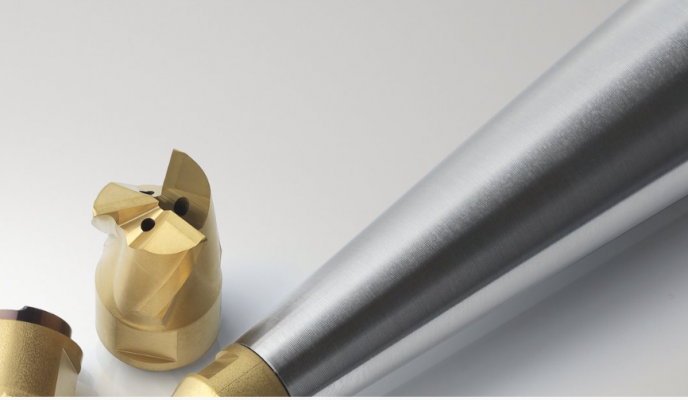Effective Approach To High-Speed Machining
In recent years, high-speed machining (HSM) has become a popular strategy in machining technology. Simply defined, HSM is a methodology to increase metal removal rates by using higher cutting speeds, coupled with high feed rates, without compromising on the quality of finished parts.
In other terms, we can say that HSM is a strategy with the systemized approach of machining and getting more accurate parts in lesser time with the reduced machining cost. HSM, when compared with the conventional machining process, enables to increase the productivity and quality of the workpiece. It is characterized by a low depth of cut and a small radial depth of cut (low chip thickness). Therefore, both cutting speed and feed rates can be increased to very high levels. This results in low cutting forces, less heat build-up in the tool and workpiece, less burr formation, and high dimensional accuracy on the workpiece.
Key to implementing HSM strategy
The selection of cutting tools and the cutting parameters, in line with the material to be machined, plays a vital role in the successful implementation of HSM. For effective machining, it is essential that cutting edge preparation, coating, and cutter design should be in line with the application. As each material has different properties and behaves differently in cutting, the combination of edge geometry inserts style coating and the right cutting parameters are the key to successful machining while using the HSM strategy. Besides, it is the thickness of the un-deformed chip measured at the right angle of the effective cutting edge which determines the cutting forces, chip formation & chip removal, and the tool life.
The second important factor of HSM technology is the compensation or speed factor. When we are engaging a small portion of the cutter in the job, i.e. small radial engagement, the compensation factor is a possibility of increasing the cutting speeds of the cutter, which in turn reduces the machining time and improves productivity. The cutting speed factor reduces the friction time so that the heat is removed with the chips rather than being retained in the cutter or the workpiece. The reason for this is to keep the chip thickness and the working temperature in the cutting zone at the same value as for a fully engaged cutter.
Applying HPM technology
In the earlier days, HSM was used on a few applications, such as mold & die. However, we now see the trend in almost every segment, especially in the aerospace segment. As most CNC machines are equipped with a spindle with lower rpm limits (under 12,000 rpm), high-performance machining (HPM) is also a very productive strategy. Applying HPM technology means smaller radial engagement with a higher depth of cut. The importance here is maintaining the average chip thickness value by maintaining the correct feed/tooth and the speed factor values. Seeing the advantages, a lot of machining strategies like, trochoidal and dynamic machining are introduced, which is getting well supported by the latest CAD/CAM software and machine tools.
Vital advantages of HSM
Significant advantages can be achieved by using high-speed milling in the manufacturing of products made of advanced materials. Very often, high-speed machining is considered to be just a way to improve productivity resulted from faster cutting speeds than used conventionally. It is seldom emphasized that product quality can be improved as a consequence of increased accuracy and better surface finish. The advantages of HSM can be achieved only if interactions between the workpiece and the tool are taken into consideration, the machine tool has been selected in the right way, NC programs have been made correctly, right cutting parameters are used, and the safety aspects have been considered.
A big advantage of high-speed machining is that at elevated rates of speed and feed, the chip is cut and evacuated so fast that it tends to transfer little or no heat to the workpiece. At conventional machining speeds, there is time for the heat to move from chip to uncut metal and create a work-hardening condition. This increases the force needed to create a chip, which creates more heat, and on it goes. The coolant mitigates the cycle by reducing the temperature in the cutting zone and flushing away the chips. But at a very high rpm, the tool rotation throws the coolant away from the cut zone. Hence, without very high pressure or through-the-tool piping, it never reaches the cutting zone. Instead of using this low coolant pressure, the jetstream system helps improve the performance in machining. This provides a very high coolant pressure and helps in breaking, flushing, and keeping the assembly cool.
Significance of run-out of tool assembly & balance
In HSM, the run-out of the tool assembly and balance plays an important role. The run-out means all the cutting edges are not cutting with the correct chip thickness, which may lead to faster wear on the cutting edge and improper cutting. The small imbalance at this high cutting speed will give high centrifugal force, which will lead to vibrations. These vibrations result in poor surface finish, increased noise level, and lack of safety. Lesser runouts of the tool and the higher quality balance will improve the cutting tool performance and quality of the workpiece. Adaptation systems can be used, like, high precision collet chucks, hydro grip chucks, and the shrink-fit system. The back-end on high rpm machines come with HSK tapers.
Significant advantages can be achieved by using high-speed milling in the manufacturing of products made of advanced materials
Rajesh Gupta
Product manager – Milling

